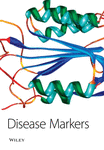Haplotype Analysis of Norwegian and Swedish Patients with Acute Intermittent Porphyria (AIP): Extreme Haplotype Heterogeneity for the Mutation R116W
Abstract
Acute intermittent porphyria (AIP), the most common of the acute porphyrias, is caused by mutations in the gene encoding hydroxymethylbilane synthase (HMBS) also called porphobilinogen deaminase (PBGD). The mutation spectrum in the HMBS gene is characterized by a majority of family specific mutations. Among the exceptions are R116W and W198X, with high prevalence in both the Dutch and Swedish populations. These two mutations were also detected in unrelated Norwegian patients. Thus, Norwegian and Swedish patients were haplotyped using closely linked flanking microsatellites and intragenic single nucleotide polymorphisms (SNPs) to see if the high frequency of these two mutations is due to a founder effect. Twelve intragenic SNPs were determined by a method based on fluorescent restriction enzyme fingerprinting single-strand conformation polymorphism (F-REF-SSCP).
W198X occurred exclusively on one haplotype in both Norwegian and Swedish patients, showing that it has originated from a common gene source. In contrast, R116W was found on three different haplotypes in three Norwegian families, and in five Swedish families on four or five haplotypes. This extreme haplotype heterogeneity indicates that R116W is a recurrent mutation, maybe explained by the high mutability of CpG dinucleotides. This can also explain why it is the only AIP mutation reported to occur in seven different populations (Norway, Sweden, Finland, Netherlands, France, Spain and South Africa).




